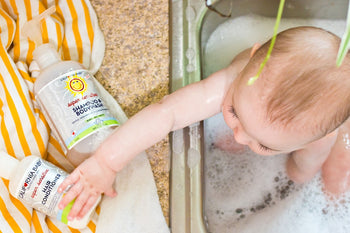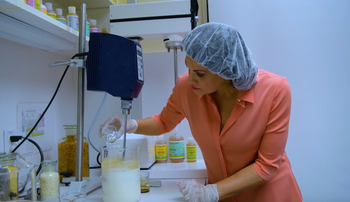Not surprisingly, we are intimately experienced with diaper rash cream for babies at California Baby HQ. And not just because we’ve done our fair share of trying every solution on the shelf. We’ve consulted pediatricians, allergists and other experts to answer our own burning questions and formulate the best solutions. Like many head-scratchers in parenthood, the answer to how often do I need to use this stuff is...it depends. Understanding what diaper rash cream actually does is the first step to knowing when and how often to use it.

What does diaper rash cream for babies do?
Diaper rash cream creates a barrier between your baby’s sensitive skin and moisture that gets trapped in by their diaper. Why is that barrier important? Because moisture creates the ideal living conditions for a hot, red and sometimes oozing fungal diaper rash — especially in all those pudgy little folds of baby bums (cue instinctive coos, because cute).
Additionally, that barrier helps reduce diaper-induced friction, the primary culprit behind dry, bumpy diaper rash, a.k.a. contact dermatitis, that’s more common on surface areas like the cheeks. And you know how much friction learning to kick, suck their toes, roll over and crawl in diapers can generate.
Should you put rash cream on every diaper change?
Yes! There’s no need to wait for the diaper rash to show up first. Using rash cream with every diaper change can help prevent diaper rash from happening in the first place. A lot of parents opt to use a rash cream for babies every time as a preventative measure, especially if their baby's skin is prone to irritation and gets rashes often. By creating a barrier with diaper cream with every change, you can stay ahead of some of the most common causes of diaper rash:
- Irritation from friction or chafing
- Diarrhea
- Teething and/or starting to eat solid foods
- Colds or antibiotics
- Sleeping through the night (yay!), which means fewer diaper changes and more time marinating in #1 and #2
Is there a right or wrong way to apply diaper rash cream?

Most types of rash cream for babies are a simple matter of spreading a thick layer directly on the irritated skin after thoroughly cleaning the whole diaper area. But like most things in parenthood, over-simplifying doesn’t always get the results we want. Jessica (founder of California Baby) created our 3-part system to give parents more safe and effective tools in their rash-fighting kit because different types of diaper rash call for different healing strategies. Here’s a quick step-by-step guide to getting the most out of your diaper rash products:
Jessica’s 3-step system to treat and prevent diaper rash
Step 1: Cleanse, but not with disposable diaper wipes
Besides being an environmental nightmare, wet wipes are just a lot of water with preservatives and fragrance, both of which can cause irritation. Plus, they require scrubbing to get the job done which certainly isn’t going to help the situation if your little one already has a painful diaper rash.
Our soothing spray-on wash makes cleaning up diaper messes easy. It’s formulated with gentle plant-based cleansers like witch hazel and soap bark extracts to break down what you don’t want sitting on your baby’s skin so it can be easily wiped away, no scrubbing required. Our favorite part? Its pleasant scent from lavender and clary sage essential oils helps neutralize dirty diaper smells. For messier jobs, like caked-on poo, use it with our reusable Organic Cotton Baby Wipes. Not only are they a sustainable alternative to wet wipes, but they are also free of the harsh chemicals and allergens that can promote diaper rash.
Step 2: Soak up excess moisture with talc-free powder
This step is most important if your baby’s diaper rash is fungal, creating a hot, moist and red rash. Our certified organic non-talc powder uses moisture-absorbing tapioca starch and kaolin clay to mop up moisture and help prevent chafing. A light dusting in the diaper area, especially in all those adorable chubby folds, will help keep the skin dry and comfortable.
Pro parent tip: You can also use our talc-free powder to keep drool-drenched areas like the folds of the neck dry to reduce irritation while your baby is teething.
Step 3: Create a barrier to treat or prevent diaper rash
Our fan-favorite rash ointment that parents swear by comes in two formulations: fragrance-free for super sensitive skin and calming lavender-scented version. Both ointments create a moisture barrier on the skin using vitamin-grade zinc oxide and ultra-purified lanolin from sheep’s wool. Thanks to our water-free formula, a little of the ultra-concentrated diaper rash ointment goes a long way. You don’t need a super thick layer like you would with a traditional diaper rash cream. Simply spread a thin layer evenly over the whole diaper area starting from the front and working toward the bum.

Purified bio-based ingredients can make all the difference
Ingredients like zinc and lanolin are commonly used in personal care products, including rash cream for babies. But just because an ingredient is bio-based (sourced from plants or, in the case of lanolin, sheep’s wool) doesn't mean it’s automatically free of contaminants. Think, for example, of where those sheep have been: happily roaming the highlands and quite possibly exposed to pesticides. Pesticides don’t simply wash out of wool with a good hosing down. They need to be intentionally and methodically removed through a purification process that not all companies choose to do because it comes at a higher cost.
Not all lanolin is ultra-purified lanolin like ours. Not all zinc is vitamin-grade zinc (which literally means it’s good enough to eat). Not all essential oils like our signature-scent French lavender are tested to verify they’re free of synthetic additives. Whatever the ingredient, we choose the highest quality available, and we take that extra step (or ten) to make sure all possible contaminants are removed. And because every California Baby product is produced in our very own certified organic facility in Los Angeles, we have a lot more control over every step of the manufacturing process and can eliminate the cross-contamination common in facilities that manufacture for multiple brands.

Why does this matter for your baby’s diaper rash cream? Because all too often contaminants like pesticides, synthetic fragrances and petrochemicals are the triggers for allergies, irritation or even eczema. As parents who understand how hard it is to see your baby in pain and how frustrating it is to troubleshoot the cause of their discomfort again and again and again, we simply don’t think products touching a baby’s delicate skin should be part of the problem. When we say our diaper rash products are free of common allergens, mineral oils and synthetic fragrances, you know we mean it.

DISCLAIMER: The information contained herein should NOT be used as a substitute for the advice of an appropriately qualified and licensed physician or other health care provider. The information provided here is for informational purposes only.














